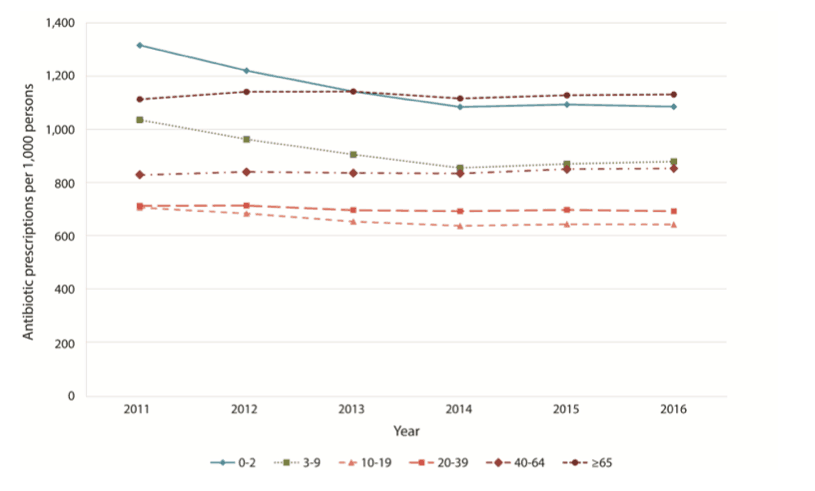April 01, 2019

Drop in overall antibiotic prescribing in US. Researchers used IQVIA prescription dispensing count data to describe trends in US outpatient antibiotic prescriptions between 2011-2016. Nationwide, overall oral antibiotic prescription rates dropped 5 percent from 2011 to 2016; among pediatric populations, there was a 13 percent decline. The ratio of broad- to narrow-spectrum antibiotics decreased 8 percent in that period (1.62 to 1.49), but prescribing rates in adults rose slightly (by 2 percent). In 2016, nurse practitioners and physician assistants prescribed over one fourth of all antibiotics, making them an important target for antimicrobial stewardship programs. [CID]
TB in US at all-time low. In 2018, there were a total of 9,029 new tuberculosis (TB) cases in the US representing a 0.7 percent decrease from 2017, according to the US Centers for Disease Control and Prevention (CDC). Approximately two-thirds of these cases occurred in non-US born persons. The incidence rate of TB in 2018 was 2.8 per 100,000 persons, which is the lowest number recorded since the CDC began tracking TB in 1953. [MMWR]
Short antibiotic course effective for Pseudomonas bloodstream infection. In a weighted observational cohort study of 249 patients with uncomplicated Pseudomonas aeruginosa bloodstream infection (BSI), researchers compared the incidence of recurrent infection between groups receiving short-course (8-10 days) and long-course (14-17 days) antibiotic therapies. Patients receiving short-course antibiotic therapy had similar odds of recurrent infection or death within 30 days of completing the therapy, compared to those receiving longer courses (OR=1.06). Patients receiving short-course antibiotics also spent four fewer days in the hospital on average than those receiving longer courses, researchers from Johns Hopkins University School of Medicine reported. [CID]
CDC eases Zika travel restrictions for pregnant women. The US Centers for Disease Control and Prevention (CDC) downgraded its travel restriction guidelines for pregnant women as the Zika pandemic has died down in much of the world. High prevalence of Zika immunity in the Western Hemisphere and improved control measures in the US are thought to have driven this decrease in virus transmission. Pregnant women and women who may become pregnant are urged to discuss travel-related Zika risks with their health care providers and avoid travel in areas with active Zika outbreaks. [Washington Post]
Reduced effectiveness of antimalarial therapy in Africa associated with drug resistance. In a systematic review and meta-analysis, researchers analyzed 57 studies that looked at the association between low-birth weight and malaria by sulfadoxine-pyrimethamine intermittent preventive treatment during pregnancy (IPTp), as well as molecular markers for sulfadoxine-pyrimethamine resistance. The relative risk reduction for low birthweight was 21 percent per dose of sulfadoxine-pyrimethamine. Researchers also reported a reduced effectiveness of sulfadoxine-pyrimethamine IPTp in areas with high resistance to sulfadoxine-pyrimethamine among P falciparum parasites. In a multi-variate analysis, the relative risk reduction of sulfadoxine-pyrimethamine IPTps was 7, 21, and 27 percent in high-, moderate-, and low-resistance areas, respectively. Based on these findings, researchers recommend alternative therapies be implemented in place of in areas with a great than 37 percent prevalence of the parasite. [The Lancet Infectious Diseases]
Phase 2 clinical trial show promising results for new drug to prevent C. difficile infections. Researchers conducted a double-blind randomized control trial to measure the effectiveness of ribaxamase, an oral beta-lactamase enzyme, in preventing Clostridium difficile infections among patients with lower respiratory tract infections and pneumonia. Findings show that the ribaxamase, when given to patients with lower respiratory tract infections in conjunction with intravenous ceftriaxone, reduced the incidence of C. difficile infections by 2.4 percent compared with placebo. A higher incidence of deaths was reported in the ribaxamase group but appeared to be unrelated to the trial. [The Lancet Infectious Diseases]
Ebola case total approaches 1,000. The Democratic Republic of the Congo’s (DRC’s) Ministry of Health reported 11 more cases last week bringing the outbreak total to 991 cases. The World Health Organization (WHO) noted that the recent increase in cases reflects increased security challenges. [WHO]
Antibiotic-releasing mesh envelope reduces infections from cardiac devices. In a randomized trial involving 6,983 patients, the use of an antibiotic-eluting envelope led to 40 percent fewer infections from surgeries involving the insertion of major cardiac implantable electronic devices (CIEDs) compared to standard infection-prevention strategies alone. The primary end point in the trial, defined as infection leading to system removal or revision, antibiotic therapy with infection reoccurrence, or death, occurred in only 25 patients who received the envelope compared to 42 patients in the control group. [NEJM]
Photo: US outpatient oral antibiotic prescriptions per 1,000 persons by age group (in years), 2011-2016.
Source: Changes in US Outpatient Antibiotic Prescriptions from 2011-2016. Clinical Infectious Diseases.











